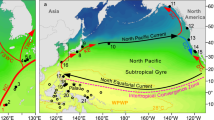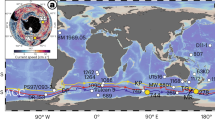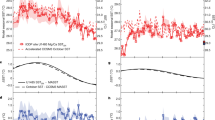Abstract
The Kuroshio current is the strong northwestern component of the subtropical North Pacific Ocean gyre, and advects a large amount of heat from the tropics to northern mid-latitudes. The Kuroshio has bimodal stationary flow patterns, with small and large meander paths east of central Japan1,2 which switch on annual and decadal timescales3,4. These switches seem to be caused by changes in current velocity and volume transport of the North Equatorial Current that are associated with variations in the trade-wind intensity in the eastern equatorial North Pacific Ocean5,6. Here we present alkenone-derived sea surface temperature records at multicentennial resolution from sediment cores from the Nishishichitou ridge off central Japan. These 25,000-year records show that the Kuroshio path has also fluctuated on millennial timescales. This variability resembles that of the subtropical high pressure of the North Pacific, reconstructed from terrestrial pollen distributions, water levels in North American lakes, and marine micropalaeontological records7. Together, these data indicate that climate variability off central Japan over the past 25,000 years may be part of a circum-Pacific phenomenon, reflecting the rate of subtropical surface circulation in the North Pacific Ocean.
This is a preview of subscription content, access via your institution
Access options
Subscribe to this journal
Receive 51 print issues and online access
$199.00 per year
only $3.90 per issue
Buy this article
- Purchase on Springer Link
- Instant access to full article PDF
Prices may be subject to local taxes which are calculated during checkout


Similar content being viewed by others
References
Nitani, H. Variation of the Kuroshio south of Japan. J. Oceanogr. Soc. Jpn 31, 154–173 (1975).
Kawabe, M. Sea level variations at the Izu Islands and typical stable paths of the Kuroshio. J. Oceanogr. Soc. Jpn 41, 307–326 (1985).
Kawabe, M. Spectral properties of sea level and time scales of Kuroshio path variations. J. Oceanogr. Soc. Jpn 43, 111–123 (1987).
Kimura, S. & Sugimoto, T. Short-period fluctuations in meander of the Kuroshio's path off Cape Shiono Misaki. J. Geophys. Res. 98, 2407–2418 (1993).
Yamagata, T., Shibao, Y. & Umatani, S. Interannual variability of the Kuroshio Extension and its relation to the Southern Oscillation/El Niño. J. Oceanogr. Soc. Jpn 41, 274–281 (1985).
Yasuda, I., Yoon, J. H. & Suginohara, N. Dynamics of the Kuroshio large meander-Barotropic model. J. Oceanogr. Soc. Jpn 41, 259–273 (1985).
COHMAP Members. Climatic changes of the last 18, 000 years: observations and model simulations. Science 241, 1043–1052 (1988).
Kaneko, A. H., Mizuno, S., Koterayama, W. & Gordon, R. L. Cross-stream velocity structures and their downstream variation of the Kuroshio around Japan. Deep-Sea Res. 39, 1583–1594 (1992).
Prahl, F. G., Muehlhausen, L. A. & Zahnle, D. L. Further evaluation of long-chain alkenones as indicators of paleoceanographic conditions. Geochim. Cosmochim. Acta. 52, 2303–2310 (1988).
Sawada, K., Handa, N., Shiraiwa, Y., Danbara, A. & Montani, S. Long-chain alkenones and alkyl alkenoates in the coastal and pelagic sediments of the northwest North Pacific with special reference to the reconstruction of Emiliania huxleyi and Gephyrocapsa oceanica ratios. Org. Geochem. 24, 751–764 (1996).
Marlowe, I. T., Brassell, S. C., Eglinton, G. & Green, J. C. Long-chain alkenones and alkyl alkenoates and the fossil coccolith record of marine sediments. Chem. Geol. 88, 349–375 (1990).
Balch, W. M., Holligan, P. M., Ackleson, S. G. & Voss, K. J. Biological and optical properties of mesoscale coccolithophore blooms in the Gulf of Maine. Limnol. Oceanogr. 36, 629–643 (1991).
Sikes, E. L. & Keigwin, L. D. Equatorial Atlantic sea surface temperature for the last 30 kyr: A comparison of U37k′, δ18O and foraminiferal assemblage temperature estimates. Paleoceanography 9, 31–45 (1994).
Sawada, K., Handa, N. & Nakatsuka, T. Production and transport of long-chain alkenones and alkyl alkenoates in sea water column in the northwestern North Pacific off central Japan. Mar. Chem.(in the press).
Bard, E. Correction of accelerator mass spectrometry 14C ages measured in planktonic foraminifera: paleoceanographic implications. Paleoceanography 3, 635–645 (1988).
Chinzei, K.et al. Postglacial environmental change of the Pacific Ocean off the coasts of central Japan. Mar. Micropaleontol. 11, 273–291 (1987).
Fairbanks, R. G. & Wiebe, P. H. Foraminifera and chlorophyll maximum: vertical distribution, seasonal succession and paleoceanographic significance. Science 209, 1524–1526 (1980).
Yang, S-K., Nagata, Y., Taira, K. & Kawabe, M. Southward intrusion of the Intermediate Oyashio Water along the east coast of the Boso Peninsula, Japan II. Intrusion events into Sagami Bay. J. Oceanogr. Soc. Jpn 49, 173–191 (1993).
CLIMAP Project Members. The surface of the ice-age earth. Science 191, 1131–1137 (1976).
Broecker, W. S. & Denton, G. H. The role of ocean-atmosphere reorganizations in glacial cycles. Geochim. Cosmochim. Acta 53, 2465–2501 (1989).
Japan Oceanographic Data Center. Marine Environmental Atlas, North western Pacific Ocean I(Japan Hydrographic Assoc., Tokyo, (1978).
Rea, D. K. The paleoclimatic record provided by eolian deposition in the deep sea: the geologic history of wind. Rev. Geophys. 32, 159–195 (1994).
Rea, D. K., Pisias, N. G. & Newberry, T. Late Pleistocene paleoclimatology of the central equatorial Pacific: Flux patterns of biogenic sediments. Paleoceanography 6, 227–244 (1991).
Farrell, J. W., Pedersen, T. F., Calvert, S. E. & Nielsen, B. Glacial-interglacial changes in nutrient utilization in the equatorial Pacific Ocean. Nature 377, 514–517 (1995).
Lyle, M. W., Prahl, F. G. & Sparrow, M. A. Upwelling and productivity changes inferred from a temperature record in the central equatorial Pacific. Nature 355, 812–815 (1992).
Berger, W. H. & Herguera, J. C. in Primary Productivity and Biogeochemical Cycle in the Sea(eds Falkowski, P. G. & Woodhead, A. D.) 455–485 (Plenum, New York, (1992).
Murayama, M., Ahagon, N., Hyong, S., Kanamatsu, T. & Taira, A. Lithology in sediment cores collected during the cruises of KT92-17 and KT93-17 (IGBP). Kaiyou Monthly 26, 434–439 (1994). (in Japanese)
Murayama, M.et al. Re-examination of the eruption age of Aira-Tn Ash (AT) obtained from a piston core off Shikoku — determined by AMS 14C dating of planktonic foraminifera. J. Geol. Soc. Jpn 99, 787–798 (1993). (in Japanese with English abstract).
Acknowledgements
We thank all the cruise members of RV Tansei-maru (KT92-17) and Hakuhou-maru (KH94-3) for collecting sediment cores; T. Nakamura and A. Ikeda for use of an accelerator mass spectrometer; and T. Oba, M. Murayama, N. Harada, N. Ahagon, T. Nakatsuka and J. I. Goes for comments and suggestions for improving the manuscript.
Author information
Authors and Affiliations
Corresponding author
Rights and permissions
About this article
Cite this article
Sawada, K., Handa, N. Variability of the path of the Kuroshio ocean current over the past 25,000 years. Nature 392, 592–595 (1998). https://doi.org/10.1038/33391
Received:
Accepted:
Issue Date:
DOI: https://doi.org/10.1038/33391
This article is cited by
-
Multi-proxy Stratigraphy and Paleoceanographic Variations in Sediment from the Korea Plateau, East Sea (Japan Sea), Over the Last 500 kyr
Ocean Science Journal (2022)
-
Enhanced North Pacific subtropical gyre circulation during the late Holocene
Nature Communications (2021)
-
Biomarkers in the rock outcrop of the Kazusa Group reveal palaeoenvironments of the Kuroshio region
Communications Earth & Environment (2021)
-
Possible climate preconditioning on submarine landslides along a convergent margin, Nankai Trough (NE Pacific)
Progress in Earth and Planetary Science (2017)
-
The Pliocene to recent history of the Kuroshio and Tsushima Currents: a multi-proxy approach
Progress in Earth and Planetary Science (2015)
Comments
By submitting a comment you agree to abide by our Terms and Community Guidelines. If you find something abusive or that does not comply with our terms or guidelines please flag it as inappropriate.



